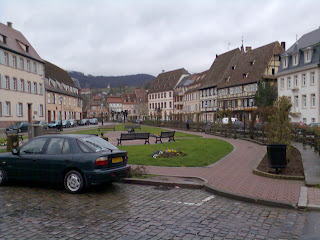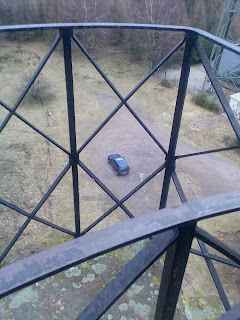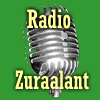Et mak isten sedzi tes te potst eri’st et tes te blog wä tsüfan aunttsspreng vor. Tügo et’st ansi bilati, et eri’st meü bitallin ew meü haräiz ï Zuraalant, te wénellauk Jameldits homzlant, int Martts 27 A.J.
Et wä an dëharäiz – vor an del an temzyurarepemin ew meü auntts räiz ï te konträ int Yüli 17 A.J. Et wés an bitallin (int Anglaz) ete 17-räiz int »The Jameld Line« eri (wist biklér tes Zuraalant, an 400-quadretkilometer parsk ew nüdlauk Elsaas int Franki nech te Déttsaz granz, »na jist an politikits entité, no an geografits konträ, int sortyilauk wïs és Rïnlant, Tsoirkhéthadaal, ëğ Mare Tranquillitatis. ... Te konträ jist nimeni pasts te watarwäi tes flat pu iet, Zur-aa«). Met iğé soch räize wen ike dëharäiz plaze au ike istave vorvor, ike will béda visen dëvö te plaze ike liubta und desdecken nüaw plaze und binelévnase ’e skaten. Zuraalant ave tsohni ghules, wïti wadines und dramatits ruéni börges, und zo me dëharäizta t’isem tsohni ghules und wïti wadines und ans ew t’isem börges, no me puprochta jund tsüdrist int ans ete thropes tes me mesrighta t’auntts tsüda und stëz moran börges tes wä nüaw vor ime.
Te drïf wrun Anglant – via te Kanaltunnel, Belgi, Lüxembörg und Déttsi – wä relativ possinmönös: et wä gut, pozirul meü auto dödaa grusem veln te voralin wökt pozirts an flati zel. Förtunlauk, pasts te helne ew t’AA (te Britaz yilaukwerthel ete ZAZ, ëğ Zuraz Automobilar Zolidaton), te doroği eldi tes optprobta bi äl bitrautssem wïl te 3 000 km räiz. | It could be said that this post is what this blog was originally created for. Although somewhat belated, this is my report of my visit to Zuraaland, the notional Jameldic homeland, in March 2008.
This was a return visit, partly a 10th-anniversary commemoration of my first trip to the area in July 1998 – a report of sorts of which can be found in The Jameld Line here (which notes that Zuraaland, a 150-square-mile area of northern Alsace in France next to the German border, “is not a political entity, but a geographical area, in much the same way as the Rhineland, the Blackmore Vale, or the Sea of Tranquillity. ... The region is named after the waterway that flows through it, the River Sauer (in Jameld, Zur-Aa)”). So, as with all such trips revisiting old haunts, one wishes to see again the places one loved and also to discover new places and experiences to treasure. Zuraaland is a place of rolling hills, forests and dramatic ruined castles, and so I revisited the same rolling hills and forests and some of the same castles, while also spending time in some of the villages I missed first time round and climbing several castles which were new to me.
The drive from England – via the Channel Tunnel, Belgium, Luxembourg and Germany – was relatively uneventful, which was just as well as my car had died spectacularly on me only a week previously with a deceased battery. However, after the ministrations of the AA that night, the old girl proved to be almost a complete paragon of reliability on the 2000-mile trip. |

T’Alfa, zeyen iet
The car made it there, and all the way back
(Klick fotos vor bigrunden)
(Click photos to enlarge) |
T’intgäl ï Zuraalant wrun Bitts int Lothring endlink te D 35/D 3 jist an threnquartwerth ew ans ete gutüt drïfviase me känne: et wés veln böya vour thropes tes ike mot biditsken vor, und te retst ete ruta jist an bilokin mighel ew linki trïtes und fasti krames pu wadinfulli daales und zessemi bargpäse, met iğé te wärpin intérets ye zicht wuntsen.
M’aa veln thren däis ’e puprinğen inte konträ, und vor t’auntts däi (an Freydäi) ergi wether wä trau vorsedzi, zo me jolkläzta na ’e bikümnen waa und lendi no ’e jolfurtsen met t’auto. Te däi bikom an expediton vor fulyen te rin ew Zur-aa wrun etü optsalt tolk ther te granz int Déttsi, pu te bitseltin daales und thropes, ï te plaz au et ajö intï Rïn-aa nëir Selz, böya 16 km nüdvest wrun Bätesü Bätes. Et wés wëth fotos, no most ist grei und migeri, zo me na tsald mackten et linkwïlsem met itemt. | The entry into Zuraaland from Bitche in Lorraine along the D 35/D 3 is three-quarters of an hour of some of the best driving roads I know – there are only about four villages to slow down for, and the rest of the route is an enticing mixture of long straights and sweeping curves through forested valleys and minor mountain passes, with all the twists and turns you could wish for.
I only had three days to spend in the area, and sadly the first day (a Friday) was forecast to have poor weather, so rather than get wet and miserable I decided to spend it exploring via vehicular means. The day turned into an expedition to trace the course of the Zur-Aa (River Sauer/Saarbach) from its origins just over the border in Germany, through the various valleys and villages, to the point where it empties into the Rhine at Seltz (about 10 miles north-west of Baden-Baden). There are lots of photos, but most of them are grey and drizzly, so I’ll spare you the details. |

Zur-aa int Wörth
The River Sauer in Wœrth |
| Inte vatsind m’ïstranta ’e dëharäizen te Brézonaz kremparé int Haaghane tes me frodha so int mëu voralin haräiz. Me yilukta met ’e fïndien iet – na wirri pasts temz yuras und met veln an vaagi repev – no et’st jüji an Tsinaz restaurant. Na krempes. | Sadly my crepuscular efforts to revisit the Breton crêperie in Haguenau I so enjoyed on my previous visit came to naught: I was overjoyed to find the place again (not bad after 10 years and only a vague memory), but it’s now a Chinese restaurant. |

Jorthelquadrat int Wissembörg, ferttstät ete Kultüreli Konträ Zuraalant
Quai Anselmann/Quai du 24 Novembre in Wissembourg, capital of the Cultural Region of Zuraaland |
| Samüdäi morn wä rïght und (ansi) klér, zo m’otparidha mi met ans firts krassones und abräizta vor bisemelen börges. Te räizruta intslét Kans’-Karlin-Päs und vour ruénes: Fleckensténbörg – aquzü t’intthrikinüt, no jüji ruéni int an jüteli nüaw wïs ük te bend-ohnmerki tsrës ew aktöres wi fénzta ’e isten quali inte karkeras; Wasgensténbörg – an tes me vista veln ot te ferth te delet tsüda, und tes optprobta met nëo untersokin und klederin ’e isten te most varalauk ew iğé Zuraz börges; Luzelhertbörg – an bifrödin peltsmassa met an torn bui ohn te top, au me steörta nanwohn an yungi pär ax te noffelin; und ï t’slüt Tsohneckbörg – lön ohn te top ew an ghul und yirighebel opt an ansi brutali 30-ménit zovat, no werthi. Te sonnen tsanta uvërd ohn ime, und me grinzta lauk an yecki grinzin lët. | Saturday dawned bright and clear(-ish), so armed with some fresh croissants I set off to bag some castles. The itinerary included my favourite placename in the area, the Col du Pfaffenschlick, followed by four ruins: Château de Fleckenstein – still the most impressive, but now ruined in a whole new way by the taped screams of actors pretending to be tortured in the dungeons; Château de Wasigenstein – one that I only saw from afar last time, and which turned out on closer inspection and clambering to be the most dangerous of the lot; Château de Lutzelhardt – a delightful lump of rock with a tower built on top, where I inadvertently disturbed a young couple mid-clinch; and finally Château de Schœneck – perched on top of a hill and reachable via a moderately brutal 30-minute climb, but worth it. The sun beat down on me, and I grinned like a mad grinning person. |

Varalauk, te börges, na wér?
Dangerous, these castles...
Fleckensténbörg
Château de Fleckenstein |

Wasgensténbörg
Château de Wasigenstein |

Wasgensténbörg, aquzü
Château de Wasigenstein, again |

Luzelhertbörg
Château de Lutzelhardt |
Te Sonnendäi te wether wä dëvö ansi erg, zo me jolfurtsta tstil an pau thropes vorvor me brükta an sonneni period vor dëharäizen Eldi Wintsténbörg, ets an oterördernlauk varalauk röti peltssül tes voralin generatones macktaa intï an (bimäudlauk) ansi nanbihaaglauk homz.
Me less te konträ Mondäi nëir mitdäi, no auntts me fulyeta an bilinki böyalïdhin vor haräizen ans thropes tes me mesrighaa, und zo an delet pelgrinräiz opt Wintersbarg, te hiüt ghul int Zuraalant, und an optstïzin ete torn ohn etü top vor eldi tsüdasü sak. | On the Sunday the weather was once again rather dubious, so I quietly explored a few villages before taking advantage of a sunny spell to revisit Château Vieux Windstein, another extraordinarily dangerous red outcrop which previous generations had fashioned into a presumably rather uncomfortable home.
I left the area on Monday at lunchtime after a protracted diversion to visit a number of villages I’d missed, but not before a final pilgrimage up Grand Wintersberg, the highest hill in Zuraaland, and an ascent of the tower on top of it for old times’ sake. |

An foto wrun te top ete torn ohn Wintersbarg
“Arty” shot from the top of the tower on Grand Wintersberg |
Zowïs köminta te ditsk, bikalmi räiz homzand tes beni böya 48 tsüdres. Intedédh, tügo me säir »ditsk«, et na jist äldrüchi: meü ruta intslét an linki delin ete Déttsaz A 1 autoruta tisk Saarbrucke und Trefs tes ave aquzü na nawnasgranz. Me lavta t’Alfa an minik extra fridhom, und et tsen tes et werthtsetha iet. Pastsand et wä an ohnyinimi pär tsüdres int Lüxembörg, pu Echternach und Diekirch, vorvor me yirighta meü ninholt, Stavelot int zudüst Belgi.
Resates wi ave benzën int t’éres tsald bikümnen elévinan wenpasts Stavelot jist nimeni, pozirts etü chadofsem historits biyungatones ï te në autoressinrondan Spa-Francorchamps. Intedédh, Stavelot jist veln an prechti tstät, no destsildyë ime: me salt jüji vorand ï te necht vorvormit, wen me drëf böyäd t’eldi rondan (most ew et jist aquzü üvretani viase). Gaasjöü... M’olt ïand t’intwäi ete niy rondan (absolut te grautüt Formul Aunt rondan tes wés, me yilob nankan) und fund tes me zochta anvülen int, wondräen pu t’ajöi tribünes, grönmen nech te lïdhplankas ohn La Source und visen é an Audi tsportauto at etü tes. Necht et köminta ’e tsnöen. Tsé me jist an dhular, no et wä vor ime an prizani und anstes surréalistits binelévnas ’e staren int Spa, visen tint te ferttrït ïand Eau Rouge inte tsnö und obzerfen an ressauto thräyen fonkes ohn an ete most dramatits kornes inte wérlt. | Thus began the slow, leisurely journey home which would take about 48 hours. Actually, I say “slow”, but that is not entirely accurate: my route took in a long stretch of the German A 1 autobahn between Saarbrücken and Trier, which is still unencumbered by speed limits. I allowed the Alfa a little extra latitude, and it seemed to appreciate the run. There followed a pleasant couple of hours in Luxembourg, passing through Echternach and Diekirch, before I eventually ended up at my stop for the night, Stavelot in south-east Belgium.
Readers with petrol running through their veins will immediately perk up at the mention of the town of Stavelot, thanks to its heady historical connections to the nearby motor racing circuit of Spa-Francorchamps. It’s actually quite a pretty town as well, but forgive me if I skip straight on to the following morning as I recall driving around the old circuit (most of which is public roads to this day). Goosebumps. I tooled up to the entrance of the modern circuit (absolutely the greatest Formula One circuit there is, in my humble opinion) and found I was able to stroll in, wander through the empty stands and loiter at the barriers at La Source hairpin watching an Audi sports car do its stuff. Then it started to snow. Call me a fool, but standing at Spa, looking down the main straight towards Eau Rouge in the snow, watching a racing car bottom out and throw sparks on one of the most dramatic corners in the world, was a glorious and slightly surreal experience. |

Eau Rouge. Oh jey
Eau Rouge. Oh yeah |
Vorvor 4 pasü te necht däi me wä homz dëvö, met an jel kofer fulli ew mol intéretsin Belğaz biares, repeves ew an otüt nanvorgeslauk räiz, und thäches böya te nüaw framkis me macktaa und t’eldi framkites me dëdesdeckaa (me tsald na mackten item bilön eri).
Int meü hant et wés an laak papir tes ave ohn iet ans willkurlauk notas: moméntes (ighblinkes, eöx ye werkilauk will), repeves, und tese tes som te binelévnas ew ’e isten au me wä. Eri’st an kur:- ’e Isten kläzi Mondäis.
- ’e Nazë kännen widar ansan tsald otkümnen ot an ëstvias ohn ikeü dreche hant.
- Eüropaz (nan-Zuraz!) wékas: dessini fränvor iğé vor biranden yeü produkton, und vor bikümnen laaz ew iet veln és an paststhäch.
- Nanpuvitsi parkbigranzines (jey, Brugge, me paptts böya iye).
- Nanbitsrati bätzomtsflures – tsé unterflurbikohli, int biyilaukaton ï item int Norwég, wist ist unterflurbitsrati. Und elektritskontaktes int bätzomtses, no na kontaktes vor skar-aparates.
- Strätes, dorogi dëpavéi, dessini vor biditsken puprïtin bikér.
- Te bigrïp ew »digos« und »aperos«.
- Eldi monnes int Elsaas wi nazë visave an drechestüri auto und wi wïz und chrije.
- Yungi monnes int Elsaas wi nazë visave an drechestüri auto und wi will kännen widar te yadrëfvas jist t’isem wäi böyäd.
- Autorutaserfisstatones au ike full te tank und necht drïf vorand ï an zëïstaton – wist jist ohn te lavte hant, zo automobilares wi drïf Britaz autos mot holten, toden te motor, otstapen und anvülen böyäd t’auto vor zëïen; et werkilauk unterhü te fulz ghregvor.
- Pinsli Déttsaz nawnasgranze: 50 kmts vor wëth kilometeres eöx te vias jist tolk an ëstiminik bëli.
- Oterlantits kussines: quadretits, ajö, und nanjolpartin.
- »Lasagne« met tsink int iet. Ëgh.
Ï te voralin m’ave tolk ets an:
- ’e Will salten dëvö int t’auto und zaräizen nanparski ï Zuraalant wen ike ïkümne homz.
| By tea-time on the following day I was back home with a half-bootful of rather interesting Belgian beers, looking back on a rather memorable trip and thinking of the new friends I’d made and the old friendships I’d rediscovered (I’ll spare their blushes here).
I have in my hand a piece of paper which bears various random scribblings: moments, memories and things which sum up the experience of being where I was. A selection:
- Being shut on Mondays.
- Never knowing whether someone’s going to emerge from a small turning on your right-hand side.
- European toilets: designed primarily to frame and display your output, and to dispose of it only as an afterthought.
- Impenetrable parking restrictions (particularly in Bruges).
- Unheated bathroom floors – possibly underfloor-refrigerated, in comparison with those in Norway, which are underfloor-heated. And power sockets in bathrooms. But no shaver points.
- Expensively recobbled streets designed to slow down through traffic.
- The concept of digos and aperos.
- Old men in Alsace who’ve never seen a right-hand-drive car and who point and shout.
- Young men in Alsace who’ve never seen a right-hand-drive car and who want to know whether the gearbox is the same way round.
- Motorway petrol stations where you fill up and then drive on to a pay station – which is on the left-hand side of the car, so drivers of British cars have to stop, turn off the ignition, get out and walk round to pay, thereby causing amusement among the drivers behind.
- Fussy German speed limits: 50 km/h for mile after mile if the road is just a little bit bumpy.
- European pillows: Square, empty, and lacking support.
- Lasagne with ham in.
To the above I have just one more to add:
- Wanting to jump back in the car and go straight back when you get home.
|
















